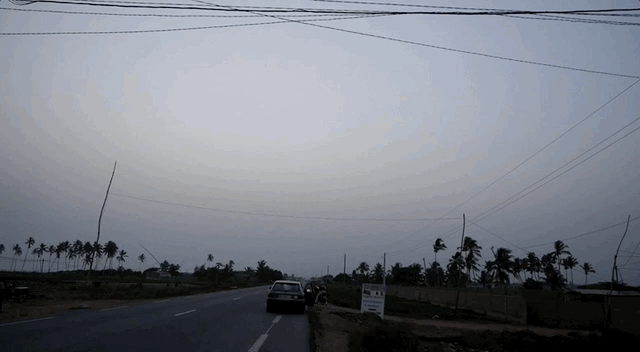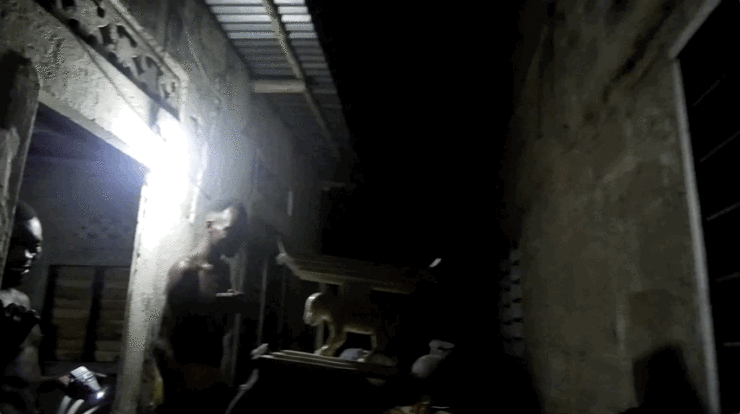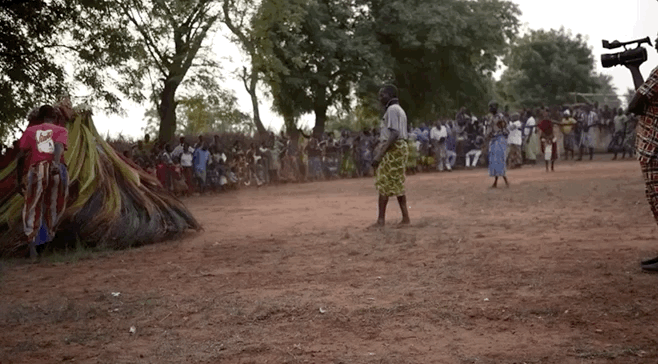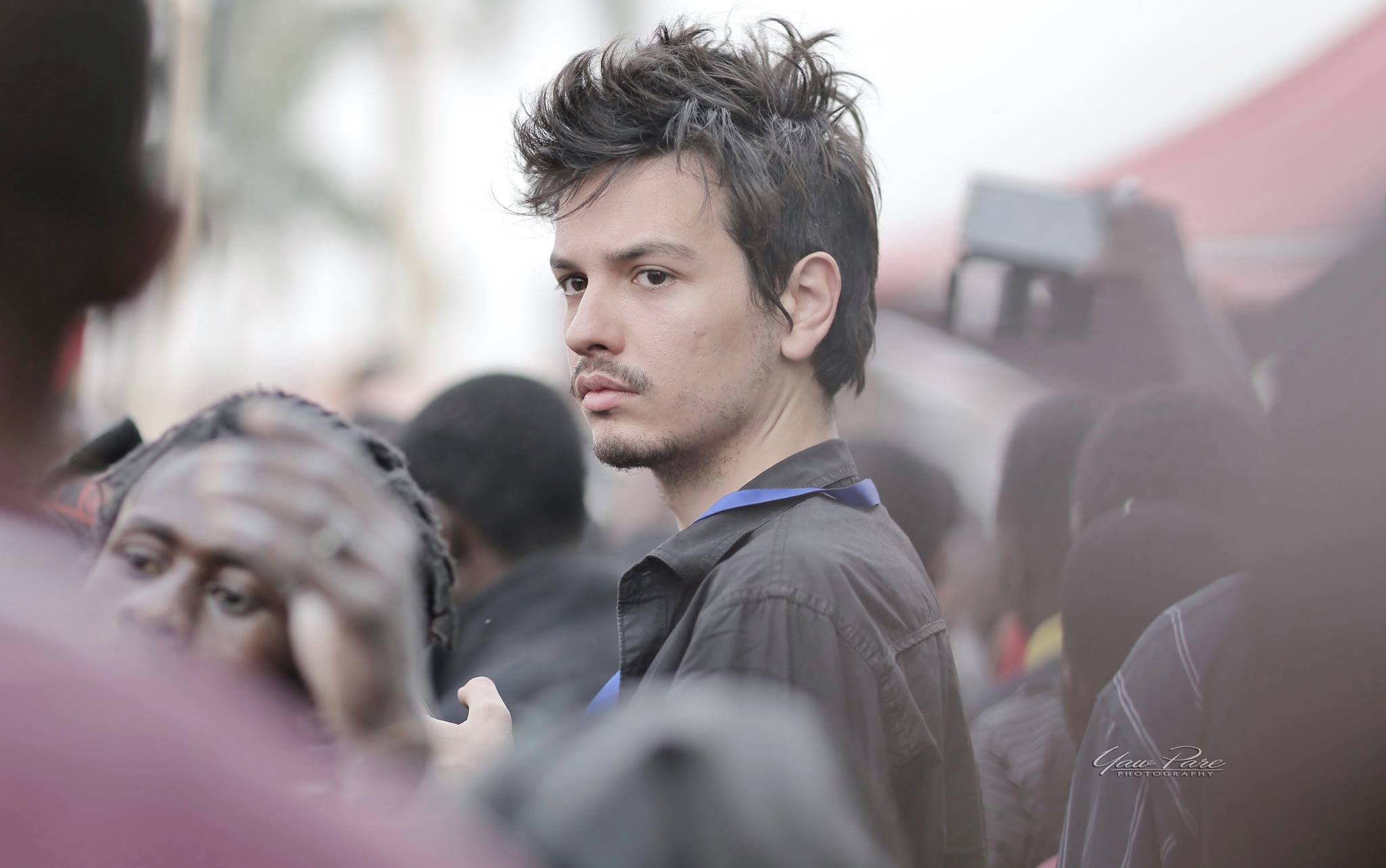January 9th, 2018, Tema, Ghana. An empty trotro is ready to leave. It is headed to the border city of Aflao, where twelve months earlier the rafia cones of Zangbeto’s spirit passed flawlessly, avoiding border controls on their way to Asantehemaa1’s funerals. The driver talks with a music manager and they agree in taking a bunch of people straight to the Togolese border. No stops in between, no other passengers, no product placement preaching or sakawa2 movie screenings. And the chance for the mate3 to have rest all the way to the destination.
It’s still about half through the morning, the dry and dusty air of January surrounds the vehicles spinning around the Tema roundabout, minibuses and heavy container trucks come back and forth from the harbour. Giant billboards and wall posters advertise the Crossover nights of prayers that few days before attracted Christian followers for the New Year’s Eve. The short lines of people on the roadside mark the food spots where the first meal of the day is still served. Having consumed waakye, a cooked meal of rice and beans, under the patio of a liquor shop, people start getting in the green-colored Mercedes Sprinter van. Their final destination is Ouidah, the Beninoise city of Vodou, where the yearly homonymous festival is about to take place.
Widely portrayed as the place to be to get in touch with West African spiritual practices — spelled in several ways, revealing the different colonial legacies: Vodou, Vodu, Vodoun, Voodoo and more — Ouidah has been at the center of initiatives to revive and display local and translocal culture in line with the development of heritage and identity politics since the early 1990s (Rush, 2001). Placing itself at the crossroads of a geography of African Spirituality, Ouidah built the reputation to be the city of Vodoun, attracting priests and priestesses, practitioners and researchers, people from the diaspora and first time travellers interested in seeing and being part of the annual Vodoun Festival, usually held during the first half of January. For the occasion many organized tours target tourists, adventurers and potential practitioners, offering them the opportunity to experience the festival. Right there, in the land where the Door of No Return stands in remembrance of the millions who forcefully left the continent during the slave trade era.

So, as the deal is on, the road rolls with smoke of cigarettes, some cans of beer and the vibrations coming out from a Bose bluetooth portable speaker. It’s the work-in-progress beat of a new ode to Vodu. A Ghanaian musician, who actively embraces spiritual practices of worshipping ancestors, spirits and nature, is controlling the sound as she embarks on an exploratory journey in order to see what’s there, in the so-called iconic land of African spirituality. With her, the fashion designer who curated her latest appearances, a cyberpunk writer working with Virtual Reality, a music producer, and the one who writes here. She goes by many names, the most known is the one she chose to carry and express her art with: Azizaa Mystic. Azizaa, like the little creatures from the forest, a peculiar spirit in Ewe Vodu. Her latest music video was released some weeks before, empowering women through the connection with the spiritual realm, Voodoo Pussy – Adze Kolo celebrates the attractive and dangerous nature of Ewe girls.
Burning with all your desire
I see it in your eyes
That you want to devour
Undressing me with your eyes
Now don’t you love the way i move my waist line
Am an Ewe woman, kinda dangerous
When i drink, turn up, am a freak, am a flirt
Boy, the harder you come the harder you fall
Ewe girls get -Adze kolo
Ayigbe woman, Adze Kolo
African girls get -Adze Kolo
The blacker the berry the sweeter the juice
The song is a fierce and narrative rupture statement that winks at, but also challenges, Ghanaian perception of Vodu, playing with popular imagination and social stigma. Deemed backwards but also feared and intertwined with daily activities of coping with life struggles, Vodu is a hidden resource in Ghana. Shrines and traditional priests are both recognized and stigmatized as source of troubles and life changing resolutions. That’s to say that, if Ouidah is the destination, the thread of spiritual practices connects people and places both close and distant. And once the trotro drops off the folks few meters away from the customs control, right on the other side of the border Leo, one of the organizer of the Voodoo To Go Festival of Utrecht, in The Netherlands, is waiting to take everybody to the next stop before moving across Togo.
Lomé, Ouaga, Conakry, Accra, nos proses abolissent les
frontières tracées en Allemagne.
Que les compradores se préparent, aucune pitié pour les
traitres, les disciplines de Gobineau, Jules Ferry ou
Foccart.
…
Mystérieux, Vodoo Sakpata, Vodoo Sakpata, Vodoo Sakpata
Rolling with the flow of Elom 20ce, these lines from the Voodoo Sakpata song mix French and Ewe language delivering a strong political message, recalling the colonial and postcolonial history of the African continent. Mobilizing Sakpata, a powerful earthy spirit in Vodu, capable of bringing the good as well as the bad in form of disease and misfortune, Elom 20ce claims a space for the spirit realm in present days struggle and politics. Rapper based in Lomé, he joined the group at the table for the lunch on Boulevard Circulaire sharing the LP vinyls of his latest album, Indigo. With Azizaa claiming “responsibility for quite a few views” to his Sakpata video on Youtube, the conversation clicks assessing the need for connections and reconnections of black people through the power of spiritual mediation and modern days availability of fast media technologies. The diversity, but also the similarity of the cultural backgrounds shared by the people sitting around the table — from Ghana, Togo, the Netherlands, Suriname, North America — shows that there’s no coincidence in this Vodu journey. Vodu connects and brings people together, transcending boundaries.
A few hours later, Leo’s purple van has crossed the Beninoise border and the group reaches Zogbedji shrine, around Grand Popo, on the coastal road that goes all the way to Lagos, Nigeria. Here, a two-day ceremony to offer sacrifices to the spirits is being held and Hounon Amedegnato, a priest from Togo living in Germany, together with Mathilde ter Heijne, an artist based in Berlin, are also attending as part of a co-joined project on mediating colonial history and spiritual realm. A videomaker and a sound engineer follow their movements around the compound, documenting for future’s sake.

As the day passes by, things start moving, the blue led lights are turned on and more people join from the surrounding areas. Food and drink vendors populate the courtyard till rituals finally take the scene. Stools are carried and displayed out in a procession of drumming, singing and dancing, routing around the multitude of spirits altars. Libations are delivered, gin moonshine drank and the deep into the night the food from the sacrifices is consumed. Action is ceaseless and will keep people around till the next morning, when ceremonies will continue. As for the trip to finally reach Ouidah.
The city that traded with Portuguese, British, Dutch and French, becoming a major slave trade port appears to be populated by endless cars and motorbikes. Tourists move around following and capturing what appear to be, for a one time visitor, ephemeral events happening next to the famous Temple des Pythons. A “temple where you do have to pay a ticket to get it”, someone points out. Up and down the narrow paved roads of the city center, in a crescendo of rumbling sounds and processions, crowds with shining dslr-cameras, smartphones and safari hats surround the colorful Gelede masks performing a tradition which is in constant mutation. The action is happening everywhere, following a schedule hard to grasp and an order even harder to understand. Looking from the windows of the car at the presence of altars in almost every corner, the Legba guarding house gates, the proliferation of monuments and memorial houses, it seems that in Benin things are moving quite differently compared to Ghana, the country we left from.
But the stay in the city of the former Dahomey Kingdom is short, hotels and guesthouses are fully booked and the restaurants have too many busy tables where travellers from Western countries enjoy seafood and local beers. It seems there is no place to go, on the coast where Vlisco — the Dutch textile company — recently shot the campaign to launch their New Traditions collection of fabrics. Sitting at a table, waiting to get some food, waiting for a resolution, calling and waiting for a way to be opened, the place isn’t looking very welcoming. Until Tidjani comes to offer the space of his compound in the outskirt of Ouidah.
“Please don’t judge the city by this experience. This is a particular time”, Tidjani advises while driving his van to the house. Long time friend of Leo, he welcomes everybody in the compound which he planned and built during the past years realizing a project that sounds like an egalitarian declination of the panopticon. Indeed, everywhere you stand, you get a comprehensive view of the compound, no hidden corners. The night is a very dark one, spent in tents while a young goose, named Police, patrols the area around the big building that hosts the museum Tidjani set up. As he explained the following morning, the place displays his personal collection of old Vodu and West African art. Having been involved in the art scene as a curator and collaborating with institutions in Central Europe, he had the chance to see and “bring back” extraordinary examples of pieces that had been brought, traded and smuggled into Europe. Objects that, in the imagination of Europeans, embodied and created the idea itself of the fetish — supposedly a non-logic attribution of agency to inanimate objects — a concept that from Marx onwards had quite an impact in the history to come. Countering that narrative, this journey shows how moving from one border to another, the status of Vodu knowledge fluctuates. Far from the biased image of the fetish, it is at times hidden, exposed, promoted, showcased, embraced or rejected, it is indeed a vibrant, open, debated and magnetic force that connects.
Having left Ouidah, on the way back to Ghana, the priest of the Kpakossou temple in Aklakou, a village 70 km from Lomé, set a ceremony for everybody. A long ritual to assess personal challenges, provide protection, plan the next steps of a reconnection with spiritual realm that already stressed borders, biographies and expectations. For some of the passengers that got in the trotro at Tema roundabout it was the first time in a Vodu ceremony, and even in a Vodu shrine. The beginning or the continuation of a journey into a matter that moves people in amazement and endless tension, like the colorful cones of Zangbeto’s spirits that shook crowds in awe at the arrival in Aklakou.

This blogpost is part of the research I’m conducting on the reframing and reappraisal of so-called traditional religion in Ghana. In a country where traditionalists are blamed and criticized by different Christian groups, especially Pentecostal Christianity, I look at the way they articulate spiritual matters together with digital media, design and aesthetics.
Notes
1Funeral rites of late Asantehemaa Nana Afia Kobi Serwaa Ampem II, Queen Mother of Ashanti Kingdom, were held in January 2017 in Kumasi, second largest city of Ghana.
2Movies where huge amount of money is made out of “occult” rituals (Frimpong, 2014). This genre of local cinema usually project a moralizing and stigmatized view on spiritual practices of mediation, such as Vodu (Meyer, 2015).
3In local language mate is used to call the bus conductor that helps the driver in attracting customers and collecting fares.
4See William Pietz (1985, 1987, 1988) who wrote extensively on the subject, showing the creative genesis of the fetish as a term resulting from the encounter between European merchants and people of West Africa.
References
Oduro-Frimpong, J. (2014). Sakawa Rituals and Cyberfraud in Ghanaian Popular Video Movies. African Studies Review, 57(02), 131–147.
Meyer, B. (2015). Sensational Movies Video, Vision, and Christianity in Ghana. Oakland, California: University of California Press.
Pietz, W. (1985). The Problem of the Fetish, I. Res: Anthropology and Aesthetics, 9, 5–17.
(1987). The Problem of the Fetish, II: The Origin of the Fetish. Res: Anthropology and Aesthetics, 13, 23–45.
(1988). The Problem of the Fetish, IIIa: Bosman’s Guinea and the Enlightenment Theory of Fetishism. Res: Anthropology and Aesthetics, 16, 105–124.
Rush, D. (2001). Contemporary Vodun Arts of Ouidah, Benin. African Arts, 34(4), 32–96.


